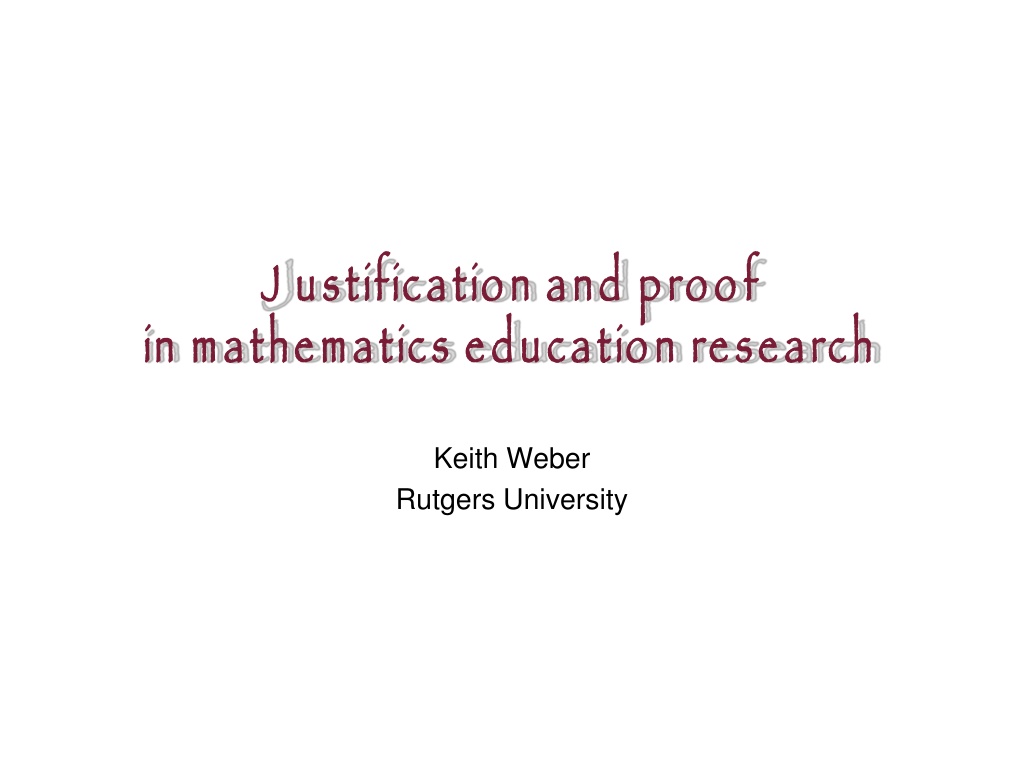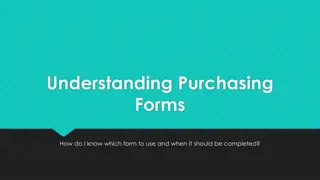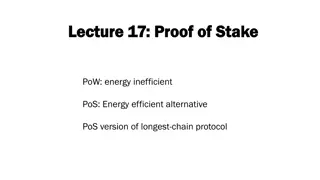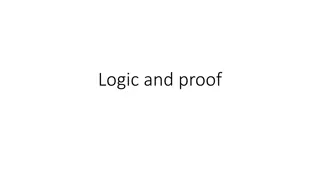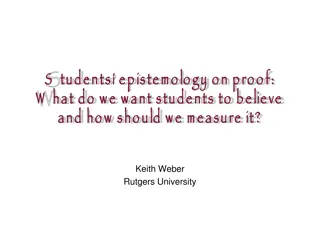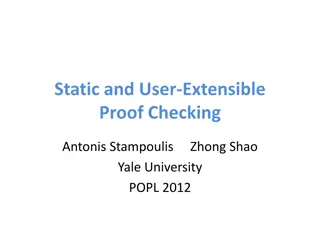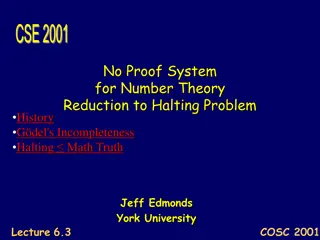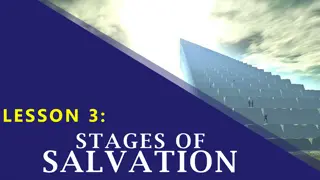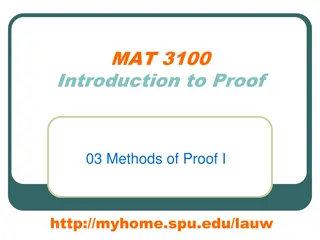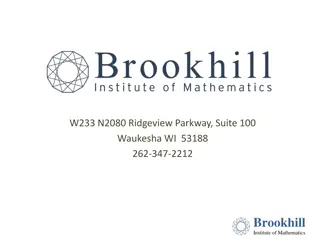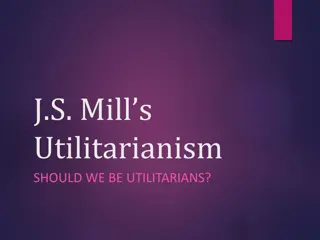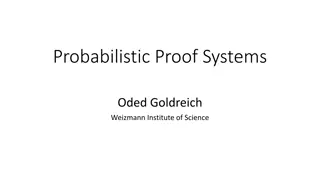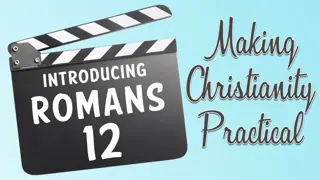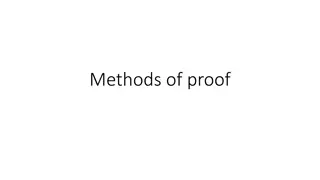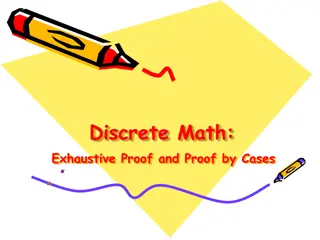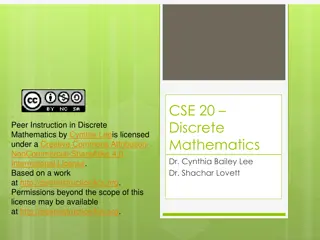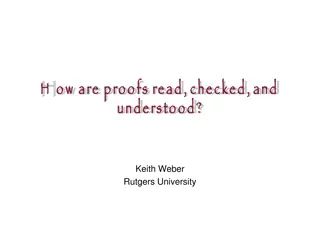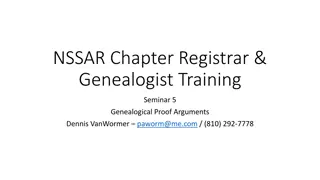Perspectives on Justification and Proof in Mathematics Education Research
This presentation explores diverse perspectives on proof in mathematics education, highlighting the role of proof in K-12 classrooms and discussing students' challenges with proof. It delves into research perspectives on what constitutes a proof, the goals of mathematics educators, and the link between proving and problem-solving. The characterization of proof and the understanding of what qualifies as a valid proof are also examined in depth.
Download Presentation

Please find below an Image/Link to download the presentation.
The content on the website is provided AS IS for your information and personal use only. It may not be sold, licensed, or shared on other websites without obtaining consent from the author. Download presentation by click this link. If you encounter any issues during the download, it is possible that the publisher has removed the file from their server.
E N D
Presentation Transcript
J ustification and proof in mathematics education research J ustification and proof in mathematics education research Keith Weber Rutgers University
T hanks T hanks To Tonya Bartell and Michigan State University for inviting me to speak To my co-authors for helping me on the chapter
M y co M y co- -authors authors Andreas Stylianides Gabriel Stylianides
M y co M y co- -authors authors Andreas Stylianides Gabriel Stylianides
O verview of this presentation O verview of this presentation Three broad perspectives on proof Why proof continues to play a marginal role in K-12 mathematics classrooms Why our collective understanding of students difficulties with proof might be less secure than we believe
B road research perspectives on justification and proof B road research perspectives on justification and proof What constitutes a proof? What are the ultimate goals of mathematics educators within this perspective? That is, what would constitute effective instruction? What intermediate questions are asked to help mathematics educators achieve these goals?
P roving as problem P roving as problem- -solving solving Proving is treated as a special case of problem solving (Gick, 1986; Koichu, Berman, & Moore, 2006; Weber, 2001, 2005). Or a proof is assumed to be a required part of a solution to a problem (Polya, 1945; Schoenfeld, 1985). Researchers tend to take an observer-oriented or expert- oriented lens. Much of this theory behind this work is drawn from the 1980 s psychology literature, such as work in information- processing perspective (Anderson et al, 2004; Koedinger & Anderson, 1990; Weber, 2001, 2006).
P roving as problem C haracterizing proof P roving as problem- -solving: C haracterizing proof solving: What counts as a proof is generally treated as unproblematic. How one codes for a proof is treated implicitly or given a formal criteria. A proof was a demonstration that the result must be true by reasoning from the given conditions to the result using a logically connected sequence of steps (Hiebert et al, 2003, p. 73). Proof could also be viewed as a strictly deductive argument that attends to the status of statements (Duval, 2007) and does not admit rebuttals (Hoyles & Kuchemann, 2002) Issues of what a proof represents to the student or a students motivation for trying to write a proof are usually not explicitly considered.
P roving as problem R esearch questions P roving as problem- -solving: R esearch questions solving: The goal is to design instruction so that students can give correct answers on proof construction tasks and other proof related tests (e.g., checking if a proof is valid). This is conceptualized in helping students developing the resources, procedural skills, and reasoning processes to write proofs effectively. Central questions: What are the skills and processes used to write a proof? Which of these skills and processes do students lack?
P roving as problem E xample of a research program P roving as problem- -solving: E xample of a research program solving: Selden and Selden (1995) noted that if we have a proof method (e.g., direct proof, proof by contradiction) for a statement, we can find the first few lines and the last few lines of the proof based on the form of the statement.
P roving as problem E xample of a research program P roving as problem- -solving: E xample of a research program solving: If f(g(x)) is an injective function, then g(x) is an injective function. (DIRECT PROOF)
P roving as problem E xample of a research program P roving as problem- -solving: E xample of a research program solving: If f(g(x)) is an injective function, then g(x) is an injective function. (DIRECT PROOF)
P roving as problem E xample of a research program P roving as problem- -solving: E xample of a research program solving: If f(g(x)) is an injective function, then g(x) is an injective function. (DIRECT PROOF) Assume f(g(x)) is an injective function. Therefore g(x) is an injective function
P roving as problem E xample of a research program P roving as problem- -solving: E xample of a research program solving: If f(g(x)) is an injective function, then g(x) is an injective function. (DIRECT PROOF) Assume f(g(x)) is an injective function. Therefore g(x) is an injective function
P roving as problem E xample of a research program P roving as problem- -solving: E xample of a research program solving: If f(g(x)) is an injective function, then g(x) is an injective function. (DIRECT PROOF) Assume f(g(x)) is an injective function. For all a,b in Dom(g), g(a)=g(b) implies a=b Therefore g(x) is an injective function
P roving as problem E xample of a research program P roving as problem- -solving: E xample of a research program solving: If f(g(x)) is an injective function, then g(x) is an injective function. (DIRECT PROOF) Assume f(g(x)) is an injective function. For all a,b in Dom(g), g(a)=g(b) implies a=b Therefore g(x) is an injective function
P roving as problem E xample of a research program P roving as problem- -solving: E xample of a research program solving: If f(g(x)) is an injective function, then g(x) is an injective function. (DIRECT PROOF) Assume f(g(x)) is an injective function. Let a and b be elements of the domain of g. g(a)=g(b) implies a=b For all a,b in Dom(g), g(a)=g(b) implies a=b Therefore g(x) is an injective function
P roving as problem E xample of a research program P roving as problem- -solving: E xample of a research program solving: If f(g(x)) is an injective function, then g(x) is an injective function. (DIRECT PROOF) Assume f(g(x)) is an injective function. Let a and b be elements of the domain of g. g(a)=g(b) implies a=b For all a,b in Dom(g), g(a)=g(b) implies a=b Therefore g(x) is an injective function
P roving as problem E xample of a research program P roving as problem- -solving: E xample of a research program solving: If f(g(x)) is an injective function, then g(x) is an injective function. (DIRECT PROOF) Assume f(g(x)) is an injective function. Let a and b be elements of the domain of g. Suppose g(a)=g(b) Thus a=b g(a)=g(b) implies a=b For all a,b in Dom(g), g(a)=g(b) implies a=b Therefore g(x) is an injective function
P roving as problem E xample of a research program P roving as problem- -solving: E xample of a research program solving: If f(g(x)) is an injective function, then g(x) is an injective function. Proof Framework (Selden & Selden, 1995) Assume f(g(x)) is an injective function. Let a and b be elements of the domain of g. Suppose g(a)=g(b) Problem solving part of the proof Thus a=b g(a)=g(b) implies a=b For all a,b in Dom(g), g(a)=g(b) implies a=b Therefore g(x) is an injective function
P roving as problem E xample of a research program P roving as problem- -solving: E xample of a research program solving: Selden and Selden provide evidence that students lack the procedural skills to recognize proof frameworks. Most math majors cannot recognize the logical if-then structure of informal statements. (e.g., all differentiable functions are continuous ). (Selden & Selden, 1995). For A->B statements, math majors will accept an argument assuming B and ending in A as a proof. (Selden & Selden, 2003; replicated in Inglis & Alcock, 2012; Weber, 2010).
P roving as problem E xample of a research program P roving as problem- -solving: E xample of a research program solving: Selden and Selden (2013) teach math majors how to prove by engaging in two stages. The formal-rhetorical part which involves choosing a proof framework and getting the beginning and ending of the proof as a procedural skill The problem-solving part which involves exploration and heuristics.
P roving as problem E xample of a research program P roving as problem- -solving: E xample of a research program solving: Selden and Selden (1995) identified a skill that students needed to write proofs They did this through theoretical analyses, although others do this by studying experts (Schoenfeld, 1985; Weber, 2001) Although this skill was procedural, others have looked at heuristics (Schoenfeld, 1985), planning (Polya, 1945), etc. Selden and Selden (1995, 2003) documented that math majors lacked this skill. Selden and Selden (2013) designed instruction to teach this skill.
P roving as convincing P roving as convincing Some have viewed proof as a convincing argument. Proof is an argument that convinces A knowledgeable mathematician (Davis & Hersh, 1981) A reasonable skeptic (Volminik, 1991) An enemy (Mason, Burton, & Stacey, 1981) A particular community at a particular time (Balacheff, 1988) An individual or particular student (Harel & Sowder, 1998) This perspective was crystallized by Harel and Sowder s (1998) seminal paper on students proof schemes, where these focused on how individuals sought to convince and persuade. A major accomplishment was shifting how we account for difficulties of proof. It was not a deficiency of problem solving but an issue of epistemic cognition (Weber, Inglis, & Mejia-Ramos, 2014).
P roving as convincing: C haracterizing proof P roving as convincing: C haracterizing proof A mathematical proof is described as an argument that is based on deductive reasoning (as opposed to empirical or authoritative evidence) on the grounds that this convinces mathematicians Issues of how students regard various types of evidence and their standards of conviction are essential. Issues of how students choose amongst valid strategies or overcome impasses tend to receive less emphasis. Students proof attempts tend to be primarily coded by the types of arguments with less interest in whether the logic is correct or some impasse was reached. Logical errors are sometimes noted, but usually not problematized as significant by the researcher.
P roving as convincing: R esearch goals P roving as convincing: R esearch goals The ultimate goal of the research is to design instruction that leads students to refine their standards of conviction to those held by mathematicians. The goal of instruction must be unambiguous- namely to gradually refine students current proof schemes to the proof schemes shared and practiced by contemporary mathematicians (Harel & Sowder, 2007). Research questions include: What are students and teachers proof schemes and/or standards of conviction?
P roving as convincing: E xample of a research program P roving as convincing: E xample of a research program Harel and Sowder (2007) define one s proof scheme as what constitutes ascertaining and persuading for that person . An (inductive) empirical proof scheme is characterized by evidence from examples and substitution of particular numbers for algebraic expressions, and so forth . A (transformational) deductive proof scheme has three essential characteristics: generality, operational thought, and logical inference . A first goal of research is to see the proof schemes of various populations (middle school students, secondary students, university students, and teachers).
P roving as convincing: E xample of a research program P roving as convincing: E xample of a research program Recio and Godino (2001) asked 429 first year university students were asked to justify a task from algebra. (Paraphrased) justify that the difference of the squares of consecutive numbers is equal to the sum of those numbers . 43% of the responses were example-based. Analogous results were found by Recio and Godino (2001) with another sample in geometry. Similar results have been found in large scale studies with middle school students (Knuth, Choppin, & Bieda, 2009) and secondary students (Healy & Hoyles, 2000).
P roving as convincing: E xample of a research program P roving as convincing: E xample of a research program Stylianides and Stylianides (2009) conducted a teaching experiment in which pre-service teachers did the following: If a circle has n dots on its circumference and segments connecting all the dots, how many regions, at most, does this split the circle into? Answers are {1,2,4,8,16,31} for n=1,2,3,4,5,6. Is the statement For all natural numbers n, 1141n2+ 1 is not a perfect square true? No, but the first counterexample exceeds 1025. PSTs accepted that empirical evidence was inherently unreliable and appreciated deduction as a useful alternative. Brown (2014) recently published a similar experiment.
P roving as convincing: E xample of a research program P roving as convincing: E xample of a research program Students proof schemes are often inferred by the types of arguments they submit. Others ask students if they find given arguments convincing or satisfying standards of proof (e.g., Martin & Harel, 1989; Segal, 2000; Weber, 2010) Instruction seeks to have students recognize the limitations of empirical arguments and the generality and utility of deductive ones. Issues of whether student can actually prove statements often is not considered; incomplete arguments are of less consequence. Other proof schemes (perceptual, authoritative) are given less attention in the literature. Mathematicians proof schemes tend to be assumed as strictly deductive, although we argue they are more nuanced than is commonly believed (Weber, Inglis, & Mejia-Ramos, 2014)
P roving as socially P roving as socially- -embedded activity embedded activity Previous research tended to downplay the social and the meaning of the activity of proving for the individual or community. Instead of the researcher defining what proof is (or should be), understanding what proof is to a community is a target of research. One goal (for some researchers) is to find out how to frame proof in the classroom to advance pedagogical goals. Research in this field is still emerging and consequently lacks a coherent theoretical perspective.
P roving activity: M athematicians P roving activity: M athematicians The role of proving to mathematicians is not solely (or even primarily) to convince, but to increase understanding (e.g., de Villiers, 1990; Hanna, 1990; Thurston, 1994). Mathematicians claim the primary reason they read proofs is to find techniques they can use in their own research (Mejia-Ramos & Weber, 2011; Rav, 1999; Weber & Mejia-Ramos, 2011). Social processes and sourcing play an important role (perhaps a primary role) in their acceptance of proofs and theorems (Weber & Mejia-Ramos, 2013). Proofs in journals are by default accepted as correct (Auslander, 2008; Mejia-Ramos & Weber, 2014; Weber & Mejia-Ramos, 2011) Many referees will defer to the expertise of the author if (s)he has done reliable work in the past (Mejia-Ramos & Weber, 2014; Muller-Hill, 2010; Weber & Mejia-Ramos, 2011)
P roving activity: P roving activity: H igh school geometry students H igh school geometry students Herbst and Brach (2006) presented standard and non-standard proof-related geometry tasks to 16 students and inferred the following about what doing proofs was to students: Proving tasks are given so the instructor can assess students ability to reason logically and communicate clearly (not for conviction or explanation) Students were not responsible for choosing initial conditions Students were not responsible (or permitted to) make assumptions or conjectures In general, much of the creative work that mathematicians do when they prove was regarded as out of bounds to students One implication is that students might reject some creative tasks that encourage mathematizing, problem-solving, and conjecturing in this environment.
P roving activity: R eform P roving activity: R eform- -oriented classrooms oriented classrooms Proving has the potential to play roles beyond conviction in inquiry classroom. Larsen and Zandieh (2008) describe the role of proof in a classroom where students re-invent definitions of mathematical concepts. As definitions and conjectures were not precisely articulated, sometimes proofs and counterexamples co-existed. When this occurred, carefully inspecting the proof led students to re-define concepts, revise conjectures, or locate hidden assumptions in the proof. These processes were analogous to the ones described Lakatos (1976) in Proofs and Refutations. Hence, proofs (even invalid ones) played a central role in creating mathematical knowledge.
R esearch on proof: O verarching comments R esearch on proof: O verarching comments In general, there are far more studies on students difficulties with proof than on interventions to address these difficulties. In comparison to other areas of mathematics education, work on proof from sociological and ethnographic perspectives is limited. Each perspective has different conceptions of what a proof is which strains communication and inhibits from math educators building upon one another s work (Balacheff, 2008; Weber, 2009). The perspectives have worthy goals, but very different goals, which makes it hard to measure progress.
R esearch on proof: O verarching comments R esearch on proof: O verarching comments Maher and Martino (1996) report on a fifth grade student in a supportive environment who produced a surprisingly sophisticated proof by cases. Frequently cited as an example that children are capable of proving if placed in a supportive environment (e.g., Stylianides, 2007) The article, the development of the idea of mathematical proof , was about how students came to appreciate deductive support for an argument rather than referring to empirical evidence. The argument violated some typical standards of proof: It was written in informal language, did not attend to the logical status of statements (what was assumed, what was deduced), and it made reference to pictures.
R esearch on proof: O verarching comments R esearch on proof: O verarching comments Several studies suggest math majors have serious difficulties with writing proofs (e.g., Hart, 1994; Moore, 1994; Weber, 2001) If Maher and Martino s students can engage in proving and math majors cannot, would we say that we can train fifth grade students to be better at proof than advanced math majors? If the math majors presented the proof-by-cases in Maher and Martino s study, would a teacher or researcher be satisfied? If a math major gave a symbolic demonstration say, since we have two independent choices for each of four spots in the tower, there are 24towers , would Maher and Martino be satisfied? Was Maher s instructional environment completely successful ? Is proving not a unitary construct but specific to class, content, teacher, and so on? (See also Mejia-Ramos, 2008, where the author compares the proofs desired by Duval with the one s produced in Boero s teaching experiments).
P roof in the classroom: R ecommendations P roof in the classroom: R ecommendations Numerous influential organizations suggest students should be engaged in proving throughout their education. NCTM (2000): Instruction should enable all students to recognize reasoning and proof as fundamental to mathematics [and] develop and evaluate arguments and proofs (p. 56). England Department of Education (2013): Students should reason mathematically by following a line of enquiry, conjecturing relationships and generalisations, and developing an argument, justification or proof using mathematical language" (Department for Education, 2013, p. 3). CCCSM (2012): Students will build a logical progression of statements to explore the truth of their conjectures .
P roof in the classroom: R ecommendations P roof in the classroom: R ecommendations Hanna and Jahnke remarked in 1996 that although there are recommendations for proof, little was known on if and how they were implemented. In the 1999 TIMSS video study, Hiebert et al (2003) reported that 39% of Japanese classes contained proof but there were too few instances in US classrooms to make an estimate of how common they were.
P roof in the classroom: C urrent status of proof P roof in the classroom: C urrent status of proof Bieda (2010) studied seven experienced US middle school teachers trained in using the Connected Mathematics Curriculum, which was rich in proving tasks. The 43 lessons that Bieda studied had a total of 73 proving tasks, which resulted in the following Many tasks were not implemented at all or only discussed in small groups Students justifications involved an appeal to examples Students gave a general argument, many of which fell below the standard of proof Students provided no justification at all.
P roof in the classroom: C urrent status of proof P roof in the classroom: C urrent status of proof Bieda (2010) attributed the failure to have proof play a larger role to several factors: Teachers in the classrooms observed did not provide sufficient feedback to sustain discussions about students conjectures and/or justifications. When a teacher provided feedback to students justifications, it was not sufficient to establish standards for proof in a mathematics classroom. For instance, teachers were just as likely to sanction a justification with a positive appraisal if it was a justification based on nonproof arguments as a justification based on general argument. (p. 377) Time constraints as perceived by the teacher Lack of training for CMP resources and in pre-service teacher ed
P roof in the classroom: D ifficulties with implementing proof P roof in the classroom: D ifficulties with implementing proof Teachers lack a knowledge of proof and cannot distinguish good proofs from bad proofs (e.g., Knuth, 2002; Stylianides, Stylianides & Schilling, 2004, 2007). Teachers hold unproductive beliefs about proof Teachers view proof as a topic of study, rather than as a tool for communicating or studying mathematics (Knuth, 2002, p. 63). Proof was viewed as something only the most advanced students could master (Bieda, 2010; Knuth, 2002; Sears, 2012). Interviews with mathematicians find they hold the same beliefs about math majors (Alcock, 2010; Harel & Sowder, 2009; Weber, 2012). For these reasons, proof is not regarded as a central topic to be taught.
P roof in the classroom: D ifficulties with implementing proof P roof in the classroom: D ifficulties with implementing proof Collective findings from textbooks indicate: There are often few tasks that invite the opportunity for proving In particular, many textbooks provide conjecturing tasks, but do not ask for justifications Most textbooks do not provide space to address students difficulties with and unproductive beliefs about proof Teachers guidebooks do not provide teaching with a discussion of, or advice about, how to introduce and scaffold proving tasks This holds true for textbooks in teacher education programs as well From International Journal of Educational Research, 64, 2014
P roof in the classroom: D ifficulties with implementing proof P roof in the classroom: D ifficulties with implementing proof The work of the teacher on proof-related tasks is underspecified. Stylianides, Stylianides, and Shilling (2013) studied three highly qualified elementary teachers implementing proof tasks and observed the following difficulties: Providing scaffolding without lowering cognitive demand Managing students pre-existing beliefs and dispositions that were geared against proof Bringing together multiple student contributions in a coherent way Responding in the moment to students questions Managing time
P roof in the classroom: S ummary P roof in the classroom: S ummary Proof appears to play a marginal role in US classrooms, despite of recommendations that it be more prominent. Teachers often lack the knowledge to evaluate contributions and the beliefs that encourage them to foster proving. Many textbooks lack sufficient proving opportunities and most teacher guidebooks do not provide support. The practical work of implementing proof-oriented tasks is under-researched and under-theorized. Little research in teacher education supports teachers w/ proof
P roof in the classroom: R ecommendations for research P roof in the classroom: R ecommendations for research There have been studies documenting that and why proof plays a marginal role in classrooms (Bieda, 2010; Sears, 2012). More studies are needed on how proof can and should actually play a role in these classrooms. Particular attention is needed on what practical work is needed by the teacher to implement these goals effectively. Intervention studies that support teachers ability to implement proof and document changes in their pedagogy are sorely needed.
H ow secure is our knowledge? H ow secure is our knowledge? It is useful to distinguish between two types of generalization: sample-to-population generalizations: where the researcher infers behavior of a larger population from the behaviors of a sample of that population analytic generalization: where the researcher generalizes a particular set of results to a broader theory, including anticipating and recognizing relevant conditions that may influence the application of the theory. May include the generation of new constructs May include the process of how particular constructs interact with one another to explain individuals behavior (cf., Firestone, 1993).
H ow secure is our knowledge? H ow secure is our knowledge? Sample-to-population Generalization Large Analytic Generalization Arbitrary (N could be 1) Factor Sample size Type of sample Representative Chosen to illustrate phenomenon Task Valid measure of construct Designed to evoke phenomenon Criteria True Useful, explanatory Comparison to other theory Sophisticated Popperian falsificationism, confirmation, results, theory inductively challenge Use other theories to explain generated, often by adapting rival theories
H ow secure is our knowledge? H ow secure is our knowledge? Students fail to write proofs due to a poor understanding of logic Sample-to-population: Some students perform poorly on a valid measure of proving Some students perform poorly on a valid measure of logic understanding There is a correlation between performance on each measure OR students show gains in proving after receiving instruction designed to boost their logic understanding. Analytic generalization: Fine-grained illustrations of how a poor understanding of logic directly impeded a student s proof-writing.
S ample S ample- -to to- -population generalization: A gold standard population generalization: A gold standard Senk (1989) conducted an investigation of cognitive factors that may explain students difficulty with proof in geometry: Over 200 geometry students, broad invitation presumably did not skew distribution of students Students were asked to write four standard proofs, two of which only involved a single deduction. Students were asked to complete a van Hiele test that was carefully constructed by the research team using a comprehensive process to assure validity. Proof writing ability correlated highly (.5-.6) with van Hiele levels
